Conceptual Framework for Disaster Management in Coastal Cities Using Climate Change Resilience and Coping Ability
Abstract
:1. Introduction
2. Materials and Methods
2.1. Study Area
2.2. Socioeconomic Status of Taiwan’s Coastline
2.3. Climate Disaster Resilience Index (CDRI)
2.4. Coping Ability (Copability)
2.5. Data Collection
2.6. Investigating the Impact of Single and Multiple Climatic Disasters on the Selection of Coping Strategies
3. Results and Discussion
3.1. The Effects of Single and Multiple Disasters on the Selection of Coping Strategies
3.2. Conceptual Framework for Disaster Management
3.2.1. 4R Package: Resource
3.2.2. 4R Package: Reason
3.2.3. 4R Package: Roadmap
3.2.4. 4R Package: Respond
3.2.5. Interdependency of 4R Package, Resilience, and Copability
4. Conclusions
- The majority of the coastal regions in Taiwan fall under the low and medium-to-low resilient categories.
- For people living in low-resilience sites, chosen coping methods were also less successful mostly due to financial and social constraints when dealing with stressful events.
- While behavioral and structural coping mechanisms were more likely to be applied when presented with two to three disasters at the same time, a technology-based approach was used when at least three disasters occur simultaneously.
- A comprehensive conceptual model for disaster management has been proposed that includes interconnections of resilience and copability analysis.
Author Contributions
Funding
Informed Consent Statement
Data Availability Statement
Conflicts of Interest
References
- Lu, X.; Liao, W.; Fang, D.; Lin, K.; Tian, Y.; Zhang, C.; Zheng, Z.; Zhao, P. Quantification of disaster resilience in civil engineering: A review. J. Saf. Sci. Resil. 2020, 1, 19–30. [Google Scholar] [CrossRef]
- Forzieri, G.; Feyen, L.; Russo, S.; Vousdoukas, M.; Alfieri, L.; Outten, S.; Migliavacca, M.; Bianchi, A.; Rojas, R.; Cid, A. Multi-hazard assessment in Europe under climate change. Clim. Chang. 2016, 137, 105–119. [Google Scholar] [CrossRef] [Green Version]
- European Union (EU). European Union (EU). European Commission Joint Research Centre Institute for Environment and Sustainability. In Concepts and Metrics for Climate Change Risk and Development: Towards an Index for Climate Resilient Development; Joint Research Centre (JRC): Ispra, Italy, 2014; ISBN 978-92-79-36876-9. [Google Scholar] [CrossRef]
- IPCC. Climate Change 2007: Climate Change Impacts, Adaptation, and Vulnerability; Cambridge University Press: Cambridge, UK, 2007. [Google Scholar]
- Füssel, H.M. Review and Quantitative Analysis of Indices of Climate Change Exposure, Adaptive Capacity, Sensitivity, and Impacts; World Bank: Washington, DC, USA, 2010. [Google Scholar]
- Klein, R.J.T.; Nicholls, R.J. Assessment of coastal vulnerability to climate change. Ambio 1999, 28, 182–187. [Google Scholar]
- Brooks, N. Vulnerability, Risk and Adaptation: A Conceptual Framework; Working Paper 38; Tyndall Centre for Climate Change Research: Norwich, UK, 2003. [Google Scholar]
- Ofori, B.Y.; Stow, A.J.; Baumgartner, J.B.; Beaumont, L.J. Influence of adaptive capacity on the outcome of climate change vulnerability assessment. Nat. Sci. Rep. 2017, 7, 12979. [Google Scholar] [CrossRef]
- Vulnerability and Adaptation Resource Group. Linking Climate Change Adaptation and Disaster Risk Management for Sustainable Poverty Reduction: A Synthesis Report; Vulnerability and Adaptation Resource Group, The World Bank: Washington, DC, USA, 2006; p. 30. [Google Scholar]
- United Nations International Strategy for Disaster Reduction. Hyogo framework for action 2005–2015: Building the resilience of nations and communities to disasters. In Proceedings of the World Conference on Disaster Reduction, Kobe, Japan, 18–22 January 2005; p. 22. [Google Scholar]
- Cohen, O.; Bolotin, A.; Lahad, M.; Goldberg, A.; Aharonson-Daniel, L. Increasing sensitivity of results by using quantile regression analysis for exploring community resilience. Ecol. Indic. 2016, 66, 497–502. [Google Scholar] [CrossRef] [Green Version]
- Cutter, S.L. The landscape of disaster resilience indicators in the USA. Nat. Hazards 2016, 80, 741–758. [Google Scholar] [CrossRef]
- Mulligan, M.; Steele, W.; Rickards, L.; Fünfgeld, H. Keywords in planning: What do we mean by ‘community resilience’? Int. Plann. Stud. 2016, 21, 348–361. [Google Scholar] [CrossRef]
- Almeida, L.Q.D.; Welle, T.; Welle, J. Disaster risk indicators in Brazil: A proposal based on the world risk index. Int. J. Disaster Risk Reduct. 2016, 17, 251–272. [Google Scholar] [CrossRef]
- Cutter, S.L.; Barnes, L.; Berry, M.; Burton, C.; Evans, E.; Tate, E.; Webb, J. A place-based model for understanding community resilience to natural disasters. Glob. Environ. Chang. 2008, 18, 598–606. [Google Scholar] [CrossRef]
- Yang, L.E.; Scheffran, J.; Süsser, D.; Dawson, R.; Chen, Y.D. Assessment of Flood Losses with Household Responses: Agent-Based Simulation in an Urban Catchment Area. Environ. Model. Assess. 2018, 23, 369–388. [Google Scholar] [CrossRef] [Green Version]
- van Aalst, M.K.; Cannon, T.; Burton, I. Community level adaptation to climate change: The potential role of participatory community risk assessment. Glob. Environ. Chang. 2008, 18, 165–179. [Google Scholar] [CrossRef]
- Carpenter, S.R.; Walker, B.H.; Anderies, J.M.; Abel, N. From metaphor to measurement: Resilience of what to what? Eco-Systems 2001, 4, 765–781. [Google Scholar] [CrossRef]
- Bahadur, A.V.; Wilkinson, E.; Tanner, T.M. Measuring resilience: An analytical review. In ODI Working Paper; Overseas Development Institute: London, UK, 2015. [Google Scholar]
- The World Bank. Climate and disaster resilience of greater Dhaka area: A micro level analysis. In Bangladesh Development Series; Paper No. 32; World Bank: Washington, DC, USA, 2015. [Google Scholar]
- Jones, L.; Tanner, T. ’Subjective resilience’: Using perceptions to quantify household resilience to climate extremes and disasters. Reg. Environ. Chang. 2017, 17, 229–243. [Google Scholar] [CrossRef] [Green Version]
- Ojerio, R.; Moseley, C.; Lynn, K.; Bania, N. Limited Involvement of Socially Vulnerable Populations in Federal Programs to Mitigate Wildfire Risk in Arizona. Nat. Hazards Rev. 2011, 12, 28–36. [Google Scholar] [CrossRef]
- Adger, W.N.; Huq, S.; Brown, K.; Conway, D.; Hulme, M. Adaptation to climate change in the developing world. Prog. Dev. Stud. 2003, 3, 179–195. [Google Scholar] [CrossRef]
- Smit, B.; Pilifosova, O. Adaptation to Climate Change in the Context of Sustainable Development and Equity Chapter 18 in Climate Change: Impacts, Adaptation, and Vulnerability—Contribution of Working Group II to the Third Assessment Report of the Intergovernmental Panel on Climate Change; Cambridge University Press: Cambridge, UK, 2001. [Google Scholar]
- Chan, M. Risk Management for Disasters in Taiwan. Japan SPOTLIGHT, the Challenge to Risk Management. 2012. Available online: https://www.jef.or.jp/journal/pdf/185th_cover03.pdf (accessed on 17 September 2021).
- Knight, C.L.; Burgin, G.; Chen, Y.F. Living with Typhoons: Disaster Management in Rural Taiwan. Final Report to the Royal Geographical Society (with IBG). 2013, p. 195. Available online: https://www.rgs.org/CMSPages/GetFile.aspx?nodeguid=e3e7f910-b484-4bc5-9d80-cd0e1dfd8e74&lang=en-GB (accessed on 22 August 2021).
- Hsu, T.W.; Shih, D.S.; Chen, W.J. Destructive Flooding Induced by Broken Embankments along Linbian Creek, Taiwan, during Typhoon Morakot. J. Hydrol. Eng. ASCE 2015, 20, 5014025. [Google Scholar] [CrossRef]
- Small, C.; Nicholls, R.J. A global analysis of human settlement in coastal zones. J. Coast. Res. 2003, 19, 584–599. [Google Scholar]
- Chiang, Y.C.; Fang, H.M.; Hsiao, S.S.; Wang, H.Y. Approaching Taiwan’s coastal management problems from the perspective of Toucheng Beach’s disappearance. Ocean Coast. Manag. 2017, 146, 170–177. [Google Scholar] [CrossRef]
- Imani, M.; Fakour, H.; Lo, S.L. Exploring Climate Disaster Resilience: Insight into City and Zone Levels of Southern Taiwan. Agriculture 2021, 11, 107. [Google Scholar] [CrossRef]
- Hsu, T.W.; Lin, T.Y.; Tseng, I.F. Human Impact on Coastal Erosion in Taiwan. J. Coast. Res. 2007, 23, 961–973. [Google Scholar] [CrossRef]
- Chen, C.L. Diversifying fisheries into tourism in Taiwan: Experiences and prospects. Ocean Coast. Manag. 2010, 53, 487–492. [Google Scholar] [CrossRef]
- Kenchington, R. Tourism in coastal and marine environments—A recreational perspective. Ocean Coast. Manag. 1993, 19, 1–16. [Google Scholar] [CrossRef]
- Chiu, P.G.; Yu, I.Y. Examining typhoon activity in the western north pacific: Difference between active and non-active years. Atmos. Sci. 2006, 34, 201–216. [Google Scholar]
- Almutairi, A.; Mourshed, M.; Ameen, R.F.M. Coastal community resilience frameworks for disaster risk management. Nat. Hazards 2020, 101, 595–630. [Google Scholar] [CrossRef] [Green Version]
- Teo, M.; Goonetilleke, A.; Ziyath, A. An integrated framework for assessing community resilience in disaster management. In Proceedings of the 9th Annual International Conference of the International Institute for Infrastructure Renewal and Reconstruction, Brisbane, Australia, 7–10 July 2013; pp. 309–314. [Google Scholar]
- Dasgupta, R.; Shaw, R. An indicator based approach to assess coastal communities’ resilience against climate related disasters in Indian Sundarbans. J. Coast. Conserv. 2015, 19, 85–101. [Google Scholar] [CrossRef]
- Rose, A. Economic resilience to disasters: Toward a consistent and comprehensive formulation. In Disaster Resilience: An Integrated Approach; Paton, D., Johnston, D., Eds.; Charles C. Thomas: Springfield, IL, USA, 2006; pp. 275–303. [Google Scholar]
- Weichselgartner, J.; Pigeon, P. The Role of Knowledge in Disaster Risk Reduction. Int. J. Disaster Risk Sci. 2015, 6, 107–116. [Google Scholar] [CrossRef] [Green Version]
- Bowen, A.; Cochrane, S.; Fankhauser, S. Climate change, adaptation and economic growth. Clim. Chang. 2012, 113, 95–106. [Google Scholar] [CrossRef] [Green Version]
- Larsen, C.A. Social Cohesion: Definition, Measurement and Developments. Institut for Statskundskab, Aalborg Universite, Denmark. 2014. Available online: https://vbn.aau.dk/ws/portalfiles/portal/207548602/85_2014_CAL.pdf (accessed on 18 July 2021).
- Hallen, R.V.d.; Jongerling, J.; Godor, B.P. Coping and resilience in adults: A cross-sectional network analysis. Anxiety Stress Coping 2020, 33, 479–496. [Google Scholar] [CrossRef]
- Zaccarelli, N.; Petrosillo, I.; Zurlini, G. Retrospective Analysis. Encycl. Ecol. 2008, 4, 3020–3029. [Google Scholar]
- Folkman, S.; Lazarus, R.S. If it changes it must be a process: Study of emotion and coping during three stages of a college examination. J. Pers. Soc. Psychol. 1985, 48, 150–170. [Google Scholar] [CrossRef] [PubMed]
- Turnbull, M.; Sterrett, C.L.; Hilleboe, A. Toward Resilience, A Guide to Disaster Risk Reduction and Climate Change Adaptation. Practical; Action Publishing Ltd.: Warwickshire, UK, 2013; p. 194. [Google Scholar]
- Folkman, S.; Moskowitz, J.T. Coping: Pitfalls and promise. Annu. Rev. Psychol. 2004, 55, 745–774. [Google Scholar] [CrossRef]
- Steinhardt, M.; Dolbier, C. Evaluation of a resilience intervention to enhance coping strategies and protective factors and decrease symptomatology. J. Am. Coll. Health 2008, 56, 445–453. [Google Scholar] [CrossRef] [PubMed]
- Coppens, C.M.; de Boer, S.F.; Koolhaas, J.M. Coping styles and behavioural flexibility: Towards underlying mechanisms. Philos. Trans. R. Soc. B Biol. Sci. 2010, 27, 4021–4028. [Google Scholar] [CrossRef] [PubMed]
- Shaw, R.; IEDM Team. Climate disaster resilience: Focus on coastal urban cities in Asia. Asian J. Environ. Disaster Manag. 2009, 1, 101–116. [Google Scholar]
- Lokonon, B.O.K. Farmers’ vulnerability to climate shocks: Insights from the Niger basin of Benin. Clim. Dev. 2019, 11, 585–596. [Google Scholar] [CrossRef]
- Møller, L.R.; Smith-Hall, C.; Meilby, H.; Rayamajhi, S.; Herslund, L.B.; Larsen, H.O.; Nielsen, J.; Byg, A. Empirically based analysis of households coping with unexpected shocks in the central Himalayas. Clim. Dev. 2019, 11, 597–606. [Google Scholar] [CrossRef]
- Mehar, M.; Mittal, S.; Prasad, N. Farmers coping strategies for climate shock: Is it differentiated by gender? J. Rural Stud. 2016, 44, 123–131. [Google Scholar] [CrossRef]
- Zimmerman, F.J.; Carter, M.R. Asset smoothing, consumption smoothing and the reproduction of inequality under risk and subsistence constraints. J. Dev. Econ. 2003, 71, 233–260. [Google Scholar] [CrossRef]
- Hoddinott, J. Shocks and their consequences across and within households in rural Zimbabwe. J. Dev. Stud. 2006, 42, 301–321. [Google Scholar] [CrossRef]
- Barrett, C.B.; Garg, T.; McBride, L. Well-being dynamics and poverty traps. Annu. Rev. Resour. Econ. 2016, 8, 303–327. [Google Scholar] [CrossRef] [Green Version]
- Ellis, F. Rural Livelihoods and Diversity in Developing Countries; Oxford University Press: Oxford, UK, 2000. [Google Scholar]
- Ansah, I.G.K.; Gardebroek, C.; Ihle, R. Shock interactions, coping strategy choices and household food security. Clim. Dev. 2021, 13, 414–426. [Google Scholar] [CrossRef]
- Lan, Y.J.; Hsu, T.W.; Lin, Y.C.; Huang, C.J. An Adaptation Due to Climate Change in Southwest Coast of Taiwan. Coast. Manag. 2013, 41, 172–189. [Google Scholar] [CrossRef]
- Teng, W.H.; Hsu, M.H.; Wu, C.H.; Chen, A. Impact of Flood Disasters on Taiwan in the Last Quarter Century. Nat. Hazards 2006, 37, 191–207. [Google Scholar] [CrossRef] [Green Version]
- Lee, Y.J. A synthesized biophysical and social vulnerability assessment for Taiwan. IOP Conf. Ser. Earth Environ. Sci. 2017, 94, 012161. [Google Scholar] [CrossRef]
- Wu, C.-C.; Jhan, H.-T.; Ting, K.-H.; Tsai, H.-C.; Lee, M.-T.; Hsu, T.-W.; Liu, W.-H. Application of Social Vulnerability Indicators to Climate Change for the Southwest Coastal Areas of Taiwan. Sustainability 2016, 8, 1270. [Google Scholar] [CrossRef] [Green Version]
- Lin, C.-Y.; Liu, S.C.; Chou, C.C.-K.; Liu, T.H.; Lee, C.-T.; Yuan, C.-S.; Shiu, C.-J.; Young, C.-Y. Longrange transport of Asian dust and air pollutants to Taiwan. Terr. Atmos. Ocean. Sci. 2004, 15, 759–784. [Google Scholar] [CrossRef] [Green Version]
- Chan, D.C. The environmental dilemma in Taiwan. J. Northeast Asian Stud. 1993, 12, 35–57. [Google Scholar]
- Lee, Y.J.; Lin, S.Y. Vulnerability and ecological footprint: A comparison between urban Taipei and rural Yunlin, Taiwan. Environ. Sci. Pollut. Res. 2020, 27, 34624–34637. [Google Scholar] [CrossRef]
- Gwee, Q.; Takeuchi, Y.; Wen, J.C.; Shaw, R. Disaster Education System in Yunlin County, Taiwan. Asian J. Environ. Disaster Manag. 2011, 3, 189–203. [Google Scholar] [CrossRef]
- Wilson, S.; Temple, B.; Milliron, M.; Vazquez, C.; Packard, M.; Rudy, B. The Lack of Disaster Preparedness by the Public and it’s Affect on Communities. Int. J. Rescue Disaster Med. 2007, 7, 2. [Google Scholar]
- Lee, Y.J. Relationships among Environmental Attitudes, Risk Perceptions, and Coping Behavior: A Case Study of Four Environmentally Sensitive Townships in Yunlin County, Taiwan. Sustainability 2018, 10, 2663. [Google Scholar] [CrossRef] [Green Version]
- New Taipei City (NTPC) Government, Taiwan. Innovative Policies. Available online: https://foreigner.ntpc.gov.tw/home.jsp?id=ca11f6fbd52e6cd5 (accessed on 24 February 2021).
- Ke, K.Y.; Lin, Y.J.; Tan, Y.C.; Pan, T.Y.; Tai, L.L.; Lee, C.A. Enhancing Local Disaster Management Network through Developing Resilient Community in New Taipei City, Taiwan. Int. J. Environ. Res. Public Health 2020, 17, 5357. [Google Scholar] [CrossRef] [PubMed]
- Chuang, M.-T.; Chen, Y.-C.; Lee, C.-T.; Cheng, C.-H.; Tsai, Y.-J.; Chang, S.-Y.; Su, Z.-S. Apportionment of the sources of high fine particulate matter concentration events in a developing aerotropolis in Taoyuan, Taiwan. Environ. Pollut. 2016, 214, 273–281. [Google Scholar] [CrossRef] [PubMed]
- Chen, J.G.; Zhong, Y.Z.; Chuang, L.Z.H.; Koppe, B.; Chien, H. Risk management of coastal water safety for recreational activities: The case of Taoyuan coast. Appl. Geogr. 2020, 117, 102173. [Google Scholar] [CrossRef]
- HChang, S.; Hsieh, H.Y. An exploratory study on land use planning of disaster prevention: A case study of Kaohsiung new town. Procedia Environ. Sci. 2013, 17, 382–391. [Google Scholar] [CrossRef] [Green Version]
- Smart City Summit & Expo (SCSE). Available online: https://smartcityonline.org.tw/pavilion.php?vip=kaohsiung (accessed on 12 March 2021).
- Global Organization of Smart Cities (GO SMART). GO SMART Opportunity Report. 2020, Volume 3. Available online: https://www.phoenixsistercities.org/wp-content/uploads/2020/04/GO-SMART-Opportunity-Report-Vol.3-1.pdf (accessed on 12 September 2021).
- Kaohsiung City Government. Available online: https://www.kcg.gov.tw/EN/News_Content.aspx?n=3788E6E04BC17563&sms=7E0BEA6C4C2D1715&s=7397933D6206936F (accessed on 25 January 2021).
- Bakkensen, L.A.; Fox-Lent, C.; Read, L.K.; Linkov, I. Validating resilience and vulnerability indices in the context of natural disasters. Risk Anal. 2017, 37, 982–1004. [Google Scholar] [CrossRef] [Green Version]
- Ji, T.; Wei, H.H.; Sim, T.; Yang, L.E.; Scheffran, J. Disaggregated validation of disaster-resilience indicators using household survey data: A case study of Hong Kong. Sustain. Cities Soc. 2021, 67, 102726. [Google Scholar] [CrossRef]
- Yang, L.E.; Chen, J.; Geng, J.; Fang, Y.; Yang, W. Social resilience and its scale effects along the historical Tea-Horse Road. Environ. Res. Lett. 2021, 16, 45001. [Google Scholar] [CrossRef]
- Corbett, J. Famine and household coping strategies. World Dev. 1988, 16, 1099–1112. [Google Scholar] [CrossRef]
- Cambridge University Land Society. 2019. Available online: https://issuu.com/culandsoc/docs/culs_2019_v13_lr.pdf_-_final_version (accessed on 14 April 2021).
- Taipei Times. Available online: http://www.taipeitimes.com/News/front/archives/2017/11/14/2003682216 (accessed on 19 December 2020).
- Yang, J.; Shi, P. Applying Analytic Hierarchy Process in Firm’s Overall Performance Evaluation: A Case Study in China. Int. J. Bus. 2002, 7, 29–46. [Google Scholar]
- Pretty, J. Social Capital and the Collective Management of Resources. Science 2003, 32, 1912–1914. [Google Scholar] [CrossRef] [PubMed] [Green Version]
- Glantz, M.H.; Gommes, R.; Ramasamy, S. Coping with a Changing Climate: Considerations for Adaptation and Mitigation in Agriculture; Food and Agriculture Organization of the United Nations: Rome, Italy, 2009. [Google Scholar]
- Food and Agriculture Organization of the United Nations (FAO). The Water-Energy-Food Nexus. A New Approach in Support of Food Security and Sustainable Agriculture; Food and Agriculture Organization of the United Nations: Rome, Italy, 2014. [Google Scholar]
- Scheraga, J.D.; Ebi, K.L.; Furlow, J.; Moreno, A.R. From Science to Policy: Developing Responses to Climate Change. In Climate Change and Human Health: Risks and Responses; Mcmichael, A.J., Campbell-Lendrum, D.H., Corvalán, C.F., Ebi, K.L., Scheraga, J.D., Woodward, A.E., Eds.; World Health Organization: Geneva, Switzerland, 2003. [Google Scholar]
- Leipold, B.; Greve, W. Resilience: A conceptual bridge between coping and development. Eur. Psychol. 2009, 14, 40–50. [Google Scholar] [CrossRef]
- Chapman, D.A.; Trott, C.D.; Silka, L.; Lickel, B.; Clayton, S. Psychological perspectives on community resilience and climate change: Insights, examples, and directions for future research. Psychol. Clim. Chang. 2018, 267–288. [Google Scholar] [CrossRef]
- Ogunbode, C.A.; Böhm, G.; Capstick, S.B.; Demski, C.; Spence, A.; Tausch, N. The resilience paradox: Flooding experience, coping and climate change mitigation intentions. Clim. Policy 2019, 19, 703–715. [Google Scholar] [CrossRef]
- Greene, G.; Paranjothy, S.; Palmer, S.R. Resilience and vulnerability to the psychological harm from flooding: The role of social cohesion. Am. J. Public Health 2015, 105, 1792–1795. [Google Scholar] [CrossRef]
- Lo, A.Y.; Chan, F. Preparing for flooding in England and Wales: The role of risk perception and the social context in driving individual action. Nat. Hazards 2017, 88, 367–387. [Google Scholar] [CrossRef]
- Walker-Springett, K.; Butler, C.; Adger, W.N. Wellbeing in the aftermath of floods. Health Place 2017, 43, 66–74. [Google Scholar] [CrossRef] [Green Version]
- Vollhardt, J.R. Altruism born of suffering and prosocial behavior following adverse life events: A review and conceptualization. Soc. Justice Res. 2009, 22, 53–97. [Google Scholar] [CrossRef]
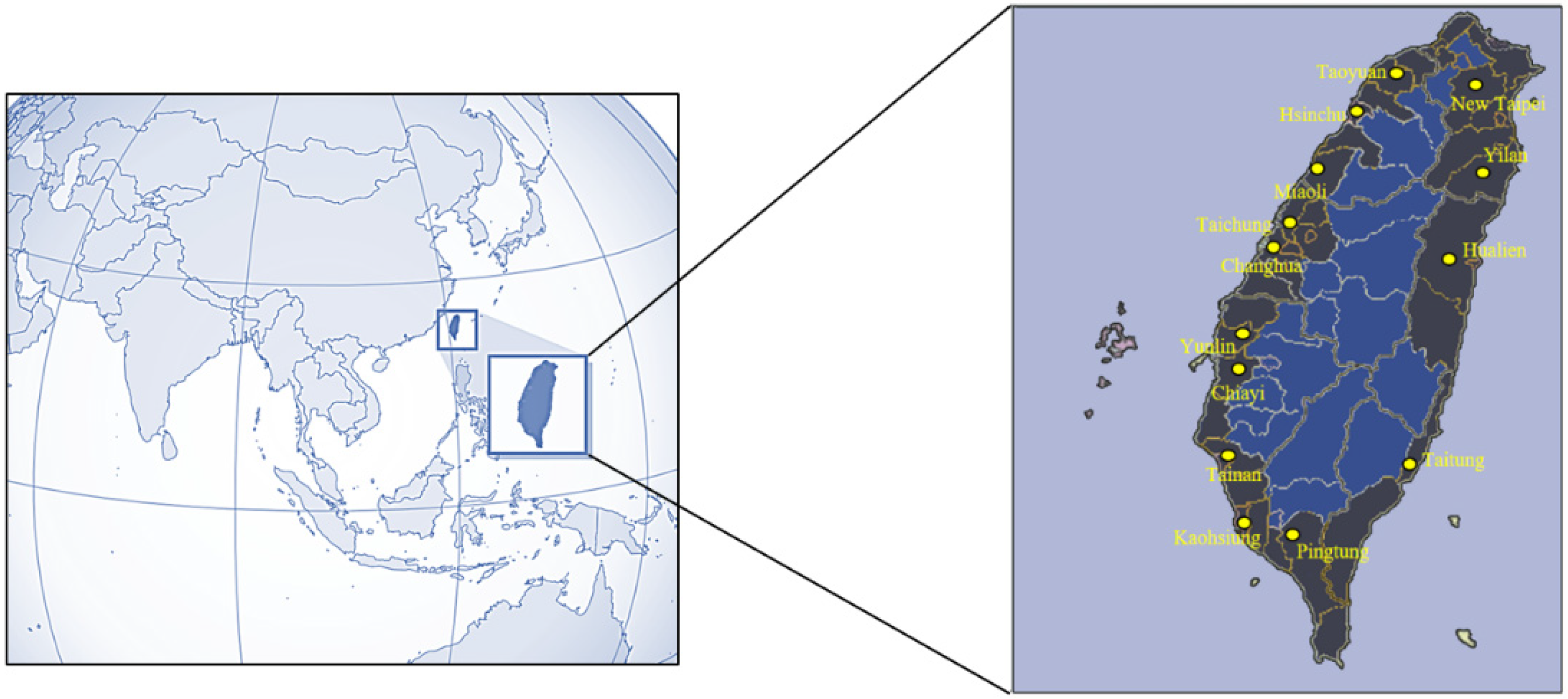
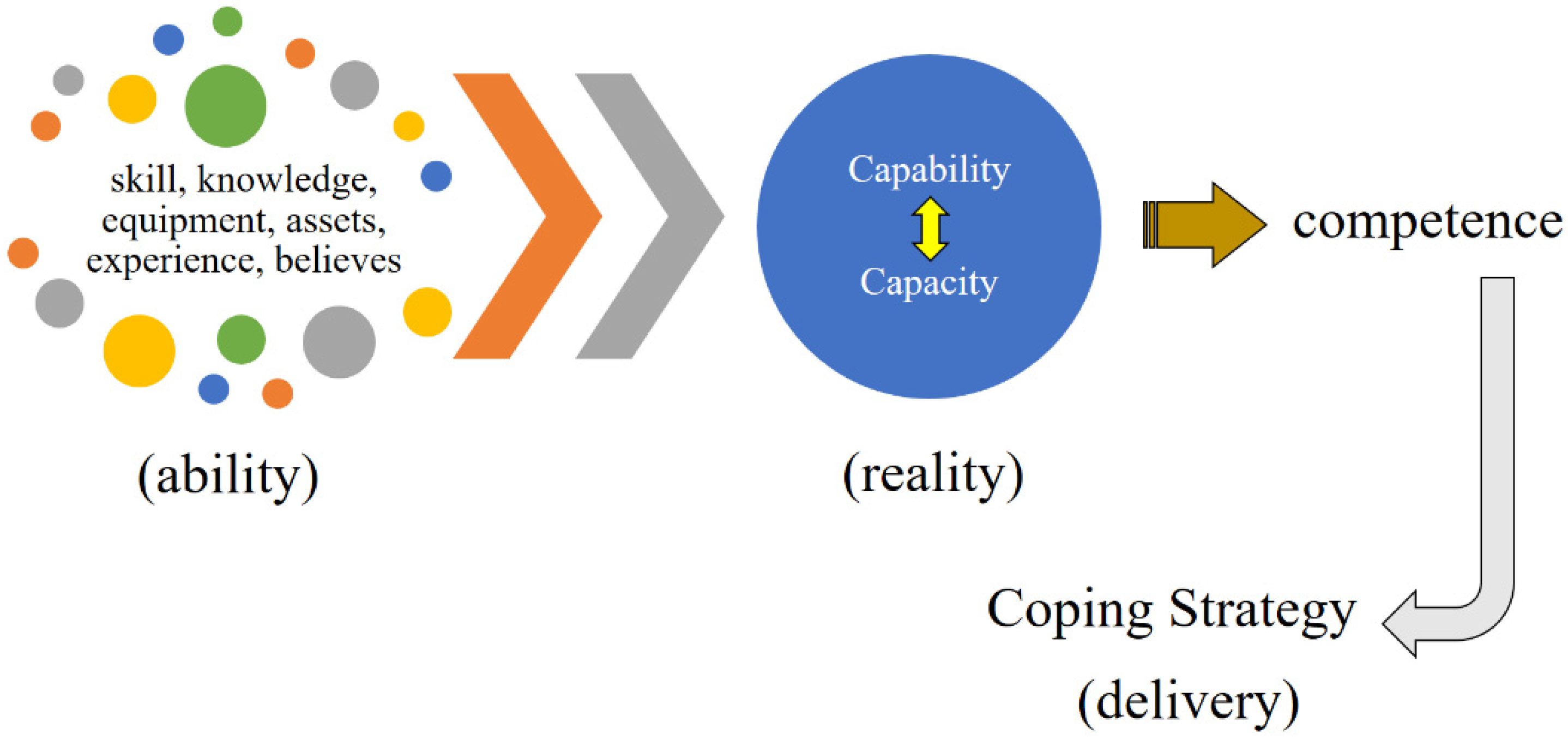


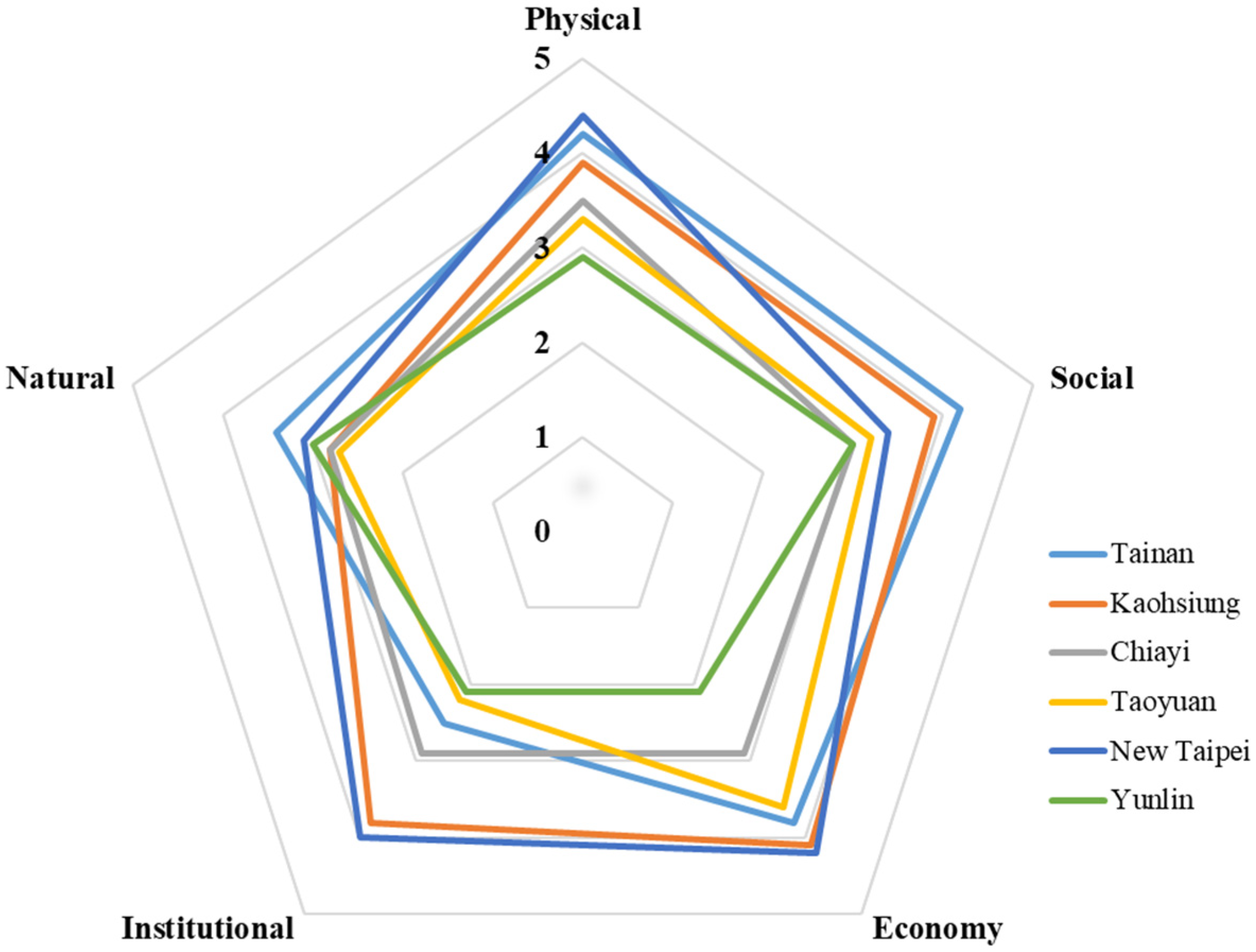
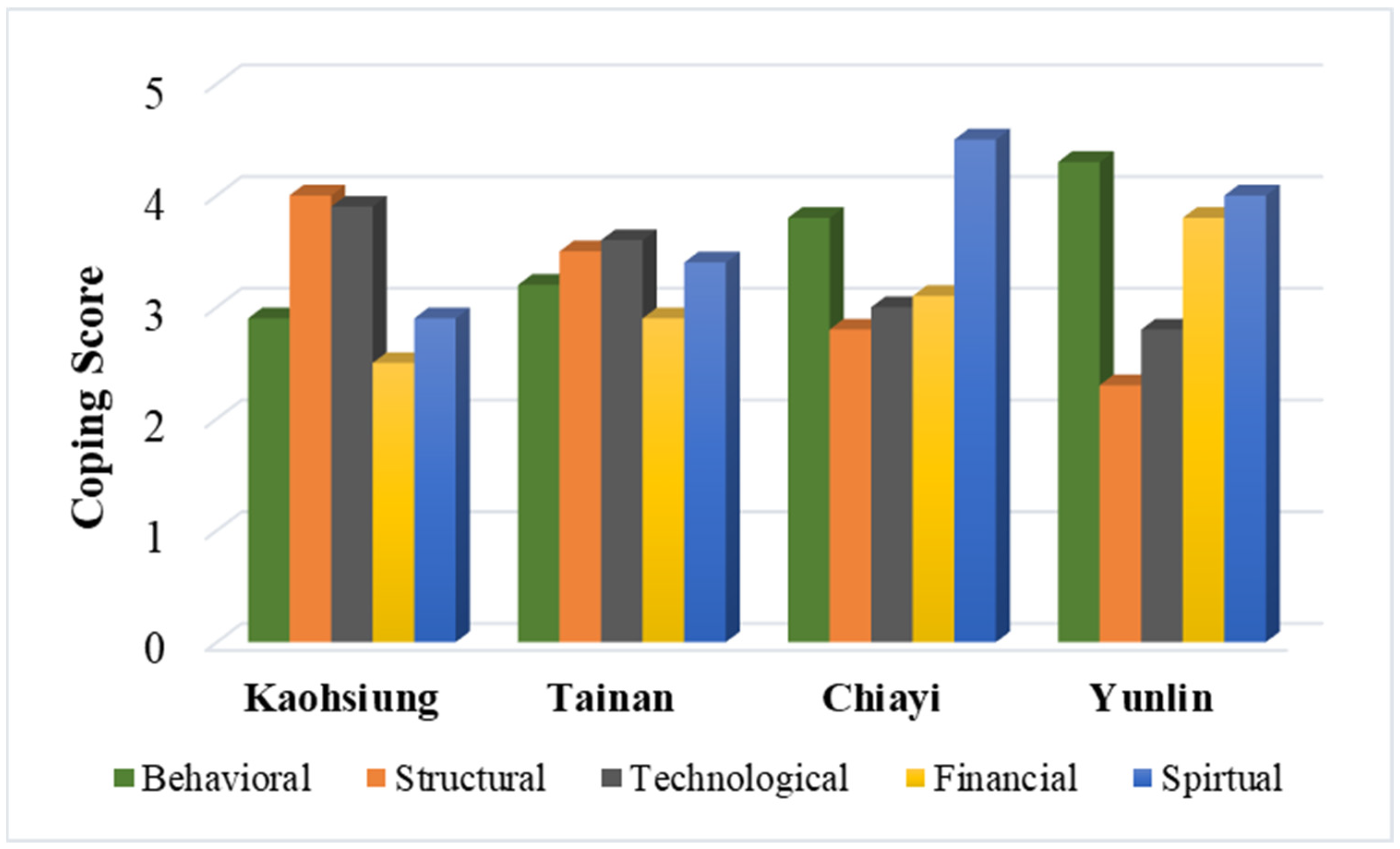
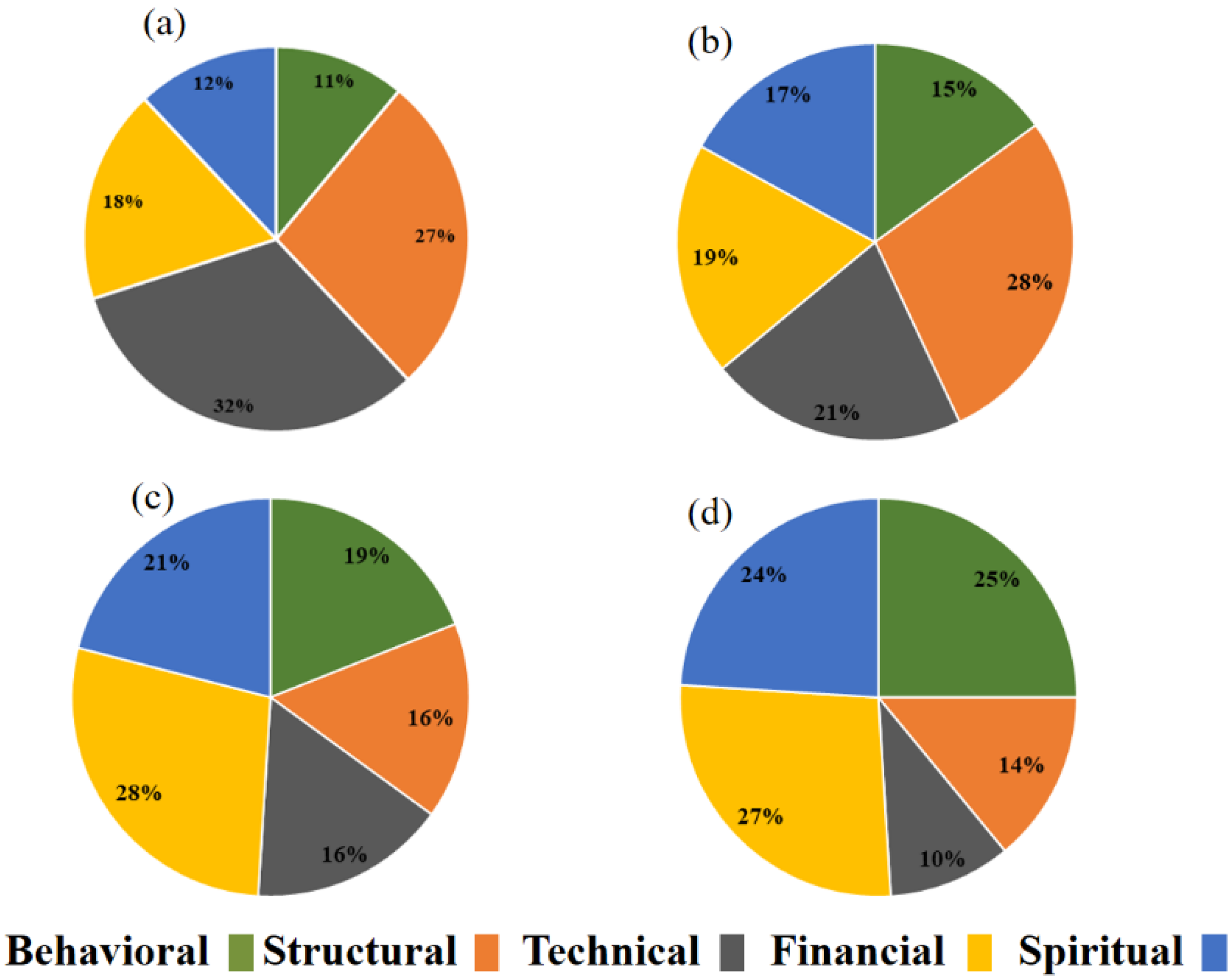

| Dimension | Parameters |
|---|---|
| Physical | Electricity, Water, Sanitation, Accessibility of roads, Housing |
| Social | Population, Health, Education and awareness, Social capital, Community preparedness during a disaster |
| Economic | Income, Employment, Household assets, Finance and savings, Budget and subsidy |
| Institutional | Knowledge dissemination, Institutional collaboration, Mainstreaming of disaster risk reduction, Effectiveness of crisis management, Good governance |
| Natural | Intensity of natural hazards, Frequency of natural hazards, Ecosystem services, Land use, Environmental policies |
| Please Rate How Effective the Following Accessibility of Roads Indicators Are in Your Area | Very Poor | Poor | Medium | Good | Very Good | |||
|---|---|---|---|---|---|---|---|---|
| 1.1.1 The percentage of land transportation network in different streets in the city during natural disaster | ① | ② | ③ | ④ | ⑤ | |||
| 1.1.2. The percentage of paved roads in the city during natural disasters. | ① | ② | ③ | ④ | ⑤ | |||
| 1.1.3. The efficiency of fixing damaged roads during and after a natural disaster. | ① | ② | ③ | ④ | ⑤ | |||
| 1.1.4. To what extent the traffic situation in your area after a natural disaster (such as intense rainfall) is handled effectively. | ① | ② | ③ | ④ | ⑤ | |||
| 1.1.5. To what extent the roadside-covered drains are equipped. | ① | ② | ③ | ④ | ⑤ | |||
| Weight factor: Please rank the variables between 1 and 5 (5 = most important, 1 = least important) | ||||||||
| 1.1.1 | 1.1.2 | 1.1.3 | 1.1.4 | 1.1.5 | ||||
| Variable | Behavioral | Structural | Technological | Financial | Spiritual |
|---|---|---|---|---|---|
| No. of disasters | 0.011 * | 0.025 | 0.028 | 0.037 | 0.162 |
| Duration of disasters | 0.042 | 0.001 | 0.095 | 0.001 | 0.029 |
| Season of the disasters | 0.083 | 0.412 | 0.103 | 0.047 | 0.371 |
| Scenario | Behavioral | Structural | Technological | Financial | Spiritual |
|---|---|---|---|---|---|
| I. One disaster vs. two disaster | 0.011 * | 0.025 | 0.071 | 0.047 | 0.162 |
| II. Two disasters vs. three disasters | 0.032 | 0.001 | 0.085 | 0.073 | 0.099 |
| III. Three disasters vs. four disasters | 0.083 | 0.412 | 0.003 | 0.129 | 0.201 |
Publisher’s Note: MDPI stays neutral with regard to jurisdictional claims in published maps and institutional affiliations. |
© 2021 by the authors. Licensee MDPI, Basel, Switzerland. This article is an open access article distributed under the terms and conditions of the Creative Commons Attribution (CC BY) license (https://creativecommons.org/licenses/by/4.0/).
Share and Cite
Imani, M.; Lo, S.-L.; Fakour, H.; Kuo, C.-Y.; Mobasser, S. Conceptual Framework for Disaster Management in Coastal Cities Using Climate Change Resilience and Coping Ability. Atmosphere 2022, 13, 16. https://doi.org/10.3390/atmos13010016
Imani M, Lo S-L, Fakour H, Kuo C-Y, Mobasser S. Conceptual Framework for Disaster Management in Coastal Cities Using Climate Change Resilience and Coping Ability. Atmosphere. 2022; 13(1):16. https://doi.org/10.3390/atmos13010016
Chicago/Turabian StyleImani, Moslem, Shang-Lien Lo, Hoda Fakour, Chung-Yen Kuo, and Shariat Mobasser. 2022. "Conceptual Framework for Disaster Management in Coastal Cities Using Climate Change Resilience and Coping Ability" Atmosphere 13, no. 1: 16. https://doi.org/10.3390/atmos13010016
APA StyleImani, M., Lo, S.-L., Fakour, H., Kuo, C.-Y., & Mobasser, S. (2022). Conceptual Framework for Disaster Management in Coastal Cities Using Climate Change Resilience and Coping Ability. Atmosphere, 13(1), 16. https://doi.org/10.3390/atmos13010016







